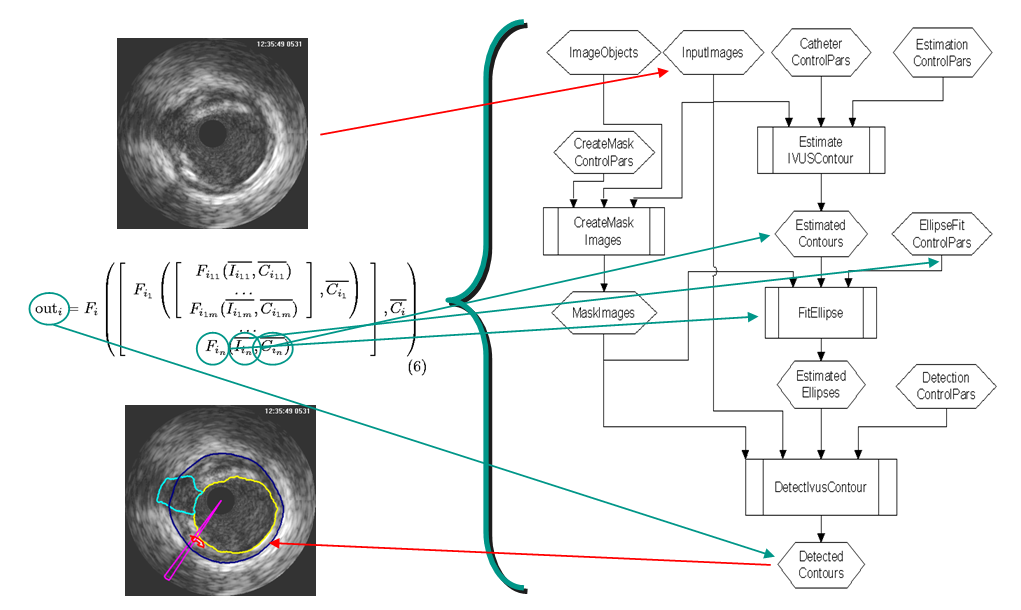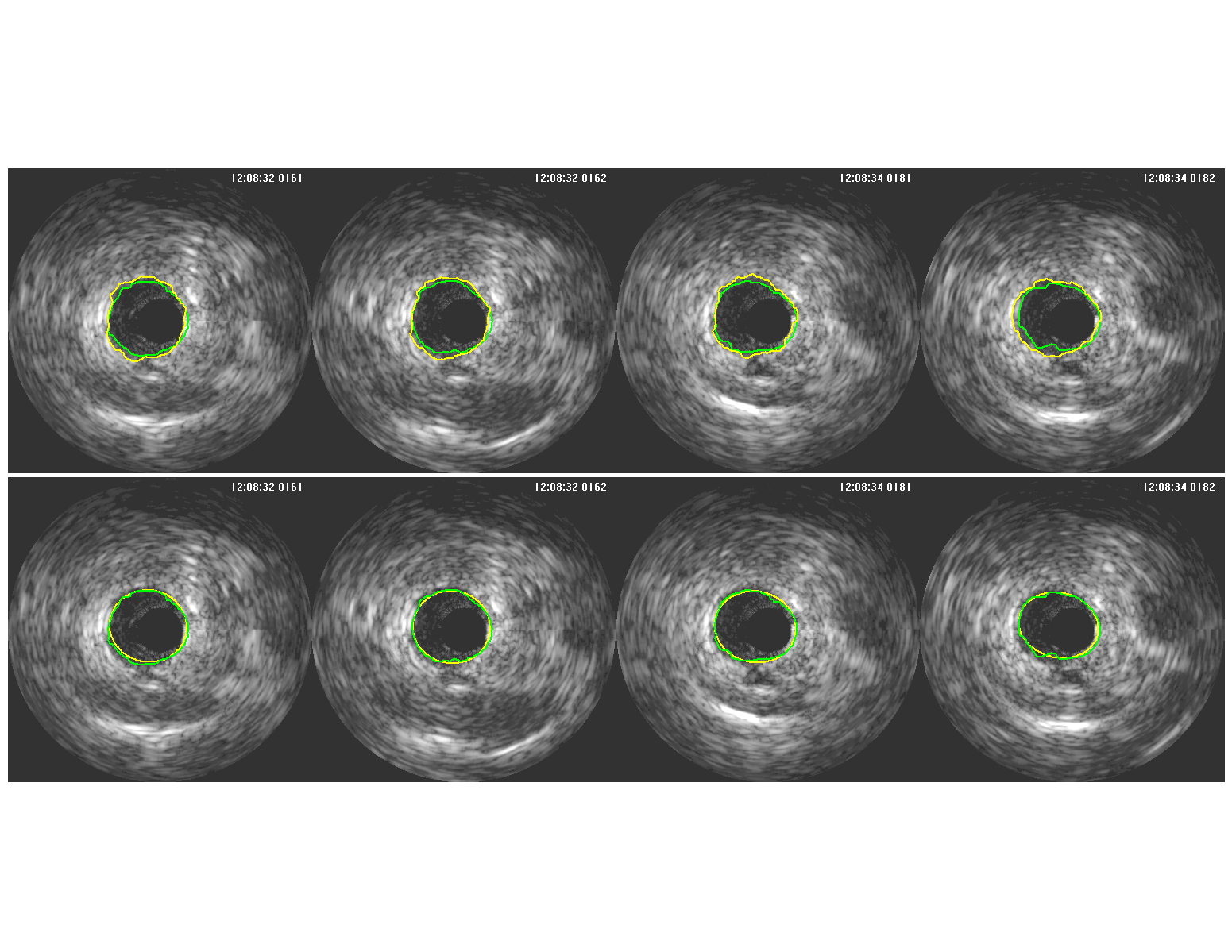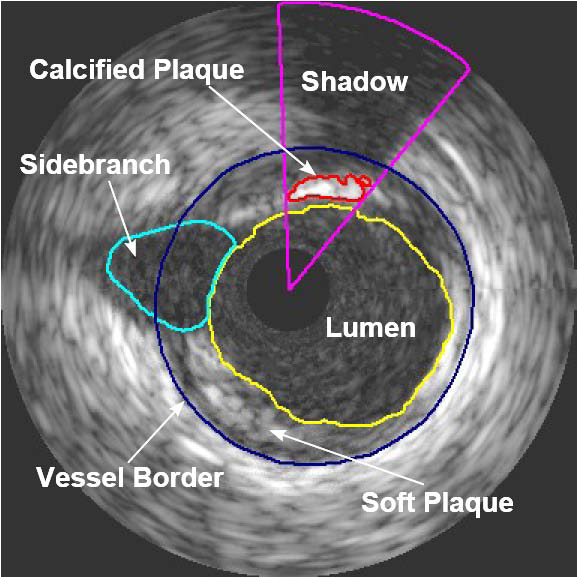SAVAGE
Self-adaptation of Vision Agents Through Genetic Evolution
LIACS - NWO - LUMC Division of Image Processing
The ultimate goal is to develop a general and adaptive learning multi-agent image interpretation system, which is more flexible and easier to adapt to changes in patient context, expert preferences, or imaging devices, by the use of both low-level training / optimization and high-level rules, and which may lead to a significant breakthrough in the field of knowledge-guided image processing.
 Figure 1: Simplified Intravascular Ultrasound (IVUS) lumen detection represented as a cascade of basic image segmentation algorithms linked together by the lumen agent.
Figure 1: Simplified Intravascular Ultrasound (IVUS) lumen detection represented as a cascade of basic image segmentation algorithms linked together by the lumen agent.
 Figure 3: Expert-drawn lumen contours (green) compared with expert-set parameter solution (yellow, top row) and MIES parameter solution (bottom row, yellow).
Figure 3: Expert-drawn lumen contours (green) compared with expert-set parameter solution (yellow, top row) and MIES parameter solution (bottom row, yellow).
|
 Figure 2: An Intravascular Ultrasound (IVUS) image with detected features: The black circle in the middle is where the ultrasound imaging device (catheter) was located. The dark area surrounding the catheter is called the lumen, which is the part of the artery where the blood flows. Above the catheter calcified plaque is detected which blocks the ultrasound signal causing a dark shadow. Between the inside border of the vessel and the lumen there is some soft plague, which does not block the ultrasound signal. The dark area left of the catheter is a sidebranch.
Figure 2: An Intravascular Ultrasound (IVUS) image with detected features: The black circle in the middle is where the ultrasound imaging device (catheter) was located. The dark area surrounding the catheter is called the lumen, which is the part of the artery where the blood flows. Above the catheter calcified plaque is detected which blocks the ultrasound signal causing a dark shadow. Between the inside border of the vessel and the lumen there is some soft plague, which does not block the ultrasound signal. The dark area left of the catheter is a sidebranch.
|
MIES
Multi Island Mixed Integer Evolution Strategy
A highlight of this research is the dynamic fitness based partitioning algorithm. This algorithm extends the MIES framework by not only optimizing the parameters for a training set, but also determining different clusters of patients for which different parameterizations of the software are optimal. Using the multi-island MIES approach the clustering and parameter optimization go hand in hand. Each island represents a cluster of images, and after the feature detector has been optimized for each one of these clusteres yielding a parameter set for each island, images that do not fit well (high training error) are redistributed to other islands, such that after several iterations of this each image is located on the island where it fits best.
The MIES as well as the dynamic fitness based partitioning are currently integrated into image analysis tools distributed by the LUMC/LKEB. The multi-island MIES was recently awarded with the best paper award of the EvoIASP conference 2008.

References:
Jeroen Eggermont, Rui Li, Ernst G.P. Bovenkamp, Henk Marquering, Michael T.M. Emmerich, Aad van der Lugt, Thomas Bäck, Jouke Dijkstra, and Hans Reiber: Optimizing Computed Tomographic Angiography Image Segmentation using Fitness Based Partitioning. Proceedings of the 10th european workshop on evolutionary computation in image analysis and signal processing (EvoIASP), Napoli, Italy, 2008
Third price in the HUMIES 2010 competition
The success of the MIES algorithm, developed within the SAVAGE project, was also acknowledged by the Evolutionary Computation community at GECCO 2010, where a submission to the HUMIES 2010 competition won the third price. The presentation is available here.


